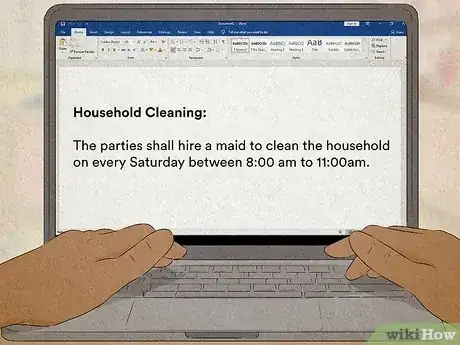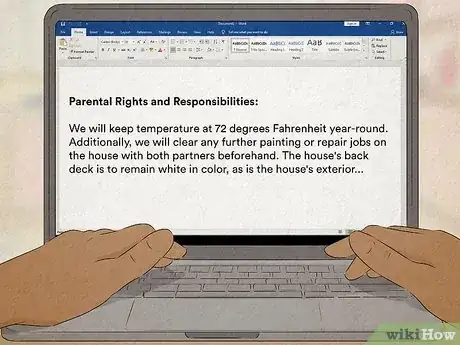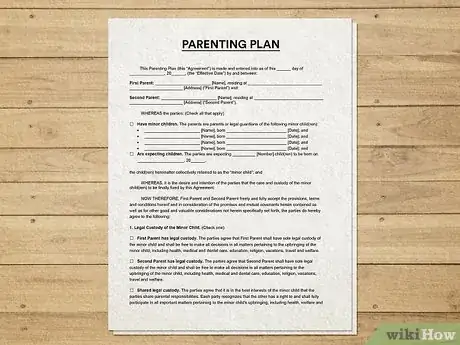This article was co-authored by Klare Heston, LCSW. Klare Heston is a Licensed Independent Clinical Social Worker based in Cleveland, Ohio. With experience in academic counseling and clinical supervision, Klare received her Master of Social Work from the Virginia Commonwealth University in 1983. She also holds a 2-Year Post-Graduate Certificate from the Gestalt Institute of Cleveland, as well as certification in Family Therapy, Supervision, Mediation, and Trauma Recovery and Treatment (EMDR).
There are 9 references cited in this article, which can be found at the bottom of the page.
This article has been viewed 61,102 times.
A bird's nest custody arrangement works around your children. Basically, your children remain in the home, and you and your ex take turns living there as well, like birds alighting on the nest. Implementing such an agreement will require some soul-searching and the ability to put in action what is quite a novel approach to raising children.
Steps
Checking If this Arrangement is Realistic
-
1Decide whether both parents will remain nearby. A bird's nest custody arrangement will only work if you're remaining close to your home. If either parent wants to move away for extended periods of time, then you probably shouldn’t try this arrangement.[1]
-
2Reach a custody agreement. A bird’s nest custody arrangement isn’t worthwhile if one parent has custody most of the time and the other parent only visits. In that case, implementing the arrangement will be too costly and time-consuming. Children are not traumatically scarred by leaving the house to visit a parent, so don’t be afraid of just establishing a regular visitation agreement instead.[2]
- A bird’s nest custody arrangement works best if you have joint or fairly equal custody.[3]
Advertisement -
3Check your finances. Each spouse needs a separate residence away from the family home in order for a bird’s nest custody arrangement to work. In total, this means three residences are maintained. They don’t need to be expensive, but they must be large enough to hold your personal belongings.
- A one-bedroom apartment, studio, or even a shared condo or house might work fine.
- It’s possible to rent a place with your ex. However, you’ll probably feel like you are invading each other’s space. For this reason, each parent should probably have their own residence outside the home.[4]
-
4Find apartments. If you think you can financially swing a bird’s nest arrangement, check how much apartments or homes cost in the area. Depending on where you live, you might not be able to find anything affordable.
- If money is tight, check whether you can stay with friends or family, at least at first.
-
5Consider whether you want to start dating. A new partner probably won’t be thrilled to live in two different places, so you need to take that into consideration. If you ever remarry and have more children, then a bird’s nest arrangement won’t work, either.
-
6Be honest with yourself. Most bird’s nest custody arrangements fail.[5] If you found it difficult to live in the same space while married, it won’t be much easier to share the same space now that you are divorced. To succeed, both parents must be committed to making the arrangement work.
- It’s possible that a bird’s nest custody agreement will be part-time, at least until you sell your house or until your young children reach a certain age.[6] In that case, it might succeed.
- Bird's nest agreements typically work best for couples that had cooperated well while married. If you and your ex disagreed on rules or practices while married, it may not be realistic to pursue a bird's nest agreement.
Laying Ground Rules
-
1Set a schedule. You need to decide who will be in the house when. If you already have a custody or visitation agreement, then use that as your template. However, if you haven’t yet set up a parenting plan, you can come up with your own schedule.
- The key is to pick a schedule you can stick with. If you don’t think you can be in the home every other week, then don’t include that in your arrangement.
-
2Describe the changeover. Although you will be sharing a house, you don’t need to be there at the same time. In fact, you should limit any overlap as much as possible. Pay particular attention to the changeover process—when one parent comes to the house and the other parent leaves.[7]
- Ideally, the changeover can happen when the children are at school. For example, one parent leaves by noon on Friday and the other parent arrives before the children return from school.
-
3Divide the bills. Since you are both sharing a house, you’ll need to divide the expenses.[8] Draw up a list of who pays for what, or open a joint checking account and have each parent deposit money into it.
- You might divide all bills 50/50. This works best when both parents make about the same amount of money and you can agree on expenses.
- You might divide expenses differently if one parent makes a lot more, or if one parent wants extra amenities. For example, your ex can pay for the expensive cable package they want.
-
4Agree on housekeeping. You and your ex might have different expectations for cleanliness and order. Reach an agreement on how clean the house will be when you leave. This is often a source of disagreement for people with a bird's nest custody arrangement.[9]
- If you can afford it, hire someone to come in once a week to clean the house between changeovers. This is a convenient way of dealing with the issue.
-
5Decide when to sell the house. Exes often disagree about whether to sell the house, which is typically your largest asset. Talk about these issues with your spouse. Cover the following topics:[10]
- Who will hold the title or mortgage? When your divorce is finalized, the judge will divide marital property, so reach an agreement on this.
- When will you sell? You can stay in the house until your children graduate high school, or you might want to sell earlier.
- How will you divide the equity when you sell? You might divide it 50/50 if both of you made equal contributions to pay for it.
-
6Be as detailed as possible. What temperature do you want the house kept at? Do you want to share dishes? Bath towels? How will your home be decorated? If you think these issues will trigger disputes with your ex, you should include them in your agreement.
- The more detailed your written agreement, the less likely you’ll have disagreements in the future.
-
7Include the agreement in your parenting plan. A judge must approve your parenting plan, which becomes a binding agreement.[11] If your bird’s nest custody arrangement is only temporary, make sure to mention that fact in your parenting plan.
Making It Work
-
1Explain the arrangement to your children. Make sure your children don’t think their parents are getting back together. This type of misunderstanding can be very painful for children. Instead, sit them down and explain how the arrangement will work.[12]
- Also tell your children why you are using a bird’s nest custody arrangement. For example, your goal might be to limit any disruption to their lives.
-
2Mediate any disputes. Disagreements will definitely arise, and you should try to resolve them in a healthy manner. For example, consider mediation. In mediation, both parents meet with a third-party neutral (the mediator), who helps them reach mutual agreement on any solution.[13]
- You can find mediators by calling your local courthouse or stopping into your city hall or town’s community center. Because many mediators are also lawyers, you should also contact your local bar association.
-
3Keep personal disputes separate. It’s very easy to confuse personal issues with parenting issues. For example, you might be upset your ex is dating again but take it out by complaining about how clean the bathroom is.[14]
- Consider attending therapy to help you deal with your personal anger at your ex separately.
-
4Make adjustments, if necessary. You might find that a bird’s nest custody arrangement doesn’t work for you. It’s hard to share space with an ex, so don't be discouraged if you need to abandon the plan. If the agreement was part of your parenting plan, contact an attorney, because you’ll need the judge’s approval to make changes.
References
- ↑ https://www.psychologytoday.com/blog/co-parenting-after-divorce/201307/birds-nest-co-parenting-arrangements
- ↑ https://www.mrcustodycoach.com/blog/birdnesting-parenting-agreement-child-custody
- ↑ https://www.psychologytoday.com/blog/co-parenting-after-divorce/201307/birds-nest-co-parenting-arrangements
- ↑ https://www.psychologytoday.com/blog/co-parenting-after-divorce/201307/birds-nest-co-parenting-arrangements
- ↑ http://scholar.smu.edu/cgi/viewcontent.cgi?article=2083&context=smulr
- ↑ http://www.lexology.com/library/detail.aspx?g=67718367-4ccd-4e64-8dd0-0f28721972d3
- ↑ http://www.lexology.com/library/detail.aspx?g=67718367-4ccd-4e64-8dd0-0f28721972d3
- ↑ http://www.lexology.com/library/detail.aspx?g=67718367-4ccd-4e64-8dd0-0f28721972d3
- ↑ http://www.lexology.com/library/detail.aspx?g=67718367-4ccd-4e64-8dd0-0f28721972d3
- ↑ https://www.avvo.com/legal-guides/ugc/nesting-will-it-work-for-you-----by-angela-i-green-esq--mediator--collaborative-counsel
- ↑ http://www.courts.ca.gov/15872.htm
- ↑ http://www.lexology.com/library/detail.aspx?g=67718367-4ccd-4e64-8dd0-0f28721972d3
- ↑ http://www.mediate.com/articles/pickell.cfm
- ↑ https://www.psychologytoday.com/blog/co-parenting-after-divorce/201307/birds-nest-co-parenting-arrangements













































































